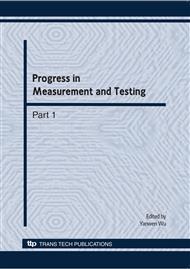[1]
Y.J. Mao and Y.L. Li: Missile and Space Vehicle No. 4 (2007), pp.37-44.
Google Scholar
[2]
R.M. Zimmerman: Pyroshock: Bibliography (SAND-93-0331C, 1993).
Google Scholar
[3]
IEST Press Release: IEST Publishes $ew RP on Pyroshock Testing, on http: /www. iest. org.
Google Scholar
[4]
Test Method Standard: Environmental Engineering Considerations and Laboratory Tests (MIL-STD-810F, Department of Defense, USA, 2000).
DOI: 10.17764/jiet.44.3.f45015p217843r36
Google Scholar
[5]
NASA Technical Standard: Pyroshock Test Criteria (NASA-STD-7003, National Aeronautics and Space Administration, USA, 1999).
Google Scholar
[6]
Y.J. Mao, X.H. Yue, H.Y. Huang, B.L. Niu and H.J. Huang: Applied Mechanics and Materials Vols. 20-23 (2010), pp.1458-1462.
Google Scholar
[7]
M. Chen, Y.K. Sui and Z.G. Yang: Initiators & Pyrotechnics No. 5 (2007), pp.5-8.
Google Scholar
[8]
Z.G. Yang, M. Chen and Y.K. Sui: Journal of Projectiles, Rockets, Missiles and Guidance Vol. 27 (2007), pp.127-130.
Google Scholar
[9]
R.F. Wang, F.Y. Lu, Z.G. Yang and G. Lü: Missiles and Space Vehicles No. 4 (2007), pp.17-20.
Google Scholar
[10]
M. de Benedetti, G. Garofalo, M. Zumpano and R. Barboni: Acta Astronautica Vol. 60 (2007), pp.947-956.
DOI: 10.1016/j.actaastro.2006.11.011
Google Scholar
[11]
Z.Y. Liu, J. Luo and G.A. Tang: Spacecraft Environment Engineering Vol. 25 (2008), pp.467-470.
Google Scholar
[12]
H.X. Sun and R.X. Fan: Missiles and Space Vehicles No. 4 (2004), pp.15-18.
Google Scholar
[13]
E.L. Wilson, A. Der Kiereghian and E. Bayo: Earthquake and Structural Dynamics Vol. 9 (1981), p.187.
Google Scholar
[14]
Regulatory Guide 1. 92, Revision 1 (Nuclear Regulatory Commission, USA, 1976).
Google Scholar
[15]
G.J. O'Hara and R.O. Belsheim: Interim Design Values for Shock Design of Shipboard Equipment (NRL Memorandum Report 1396, U.S. Naval Research Laboratory, WA, 1963).
Google Scholar
[16]
D.G. Pan, M.L. Lou and L.C. Fan: Journal of Tongji University Vol. 29 (2001), pp.1213-1219.
Google Scholar
[17]
F.L. Bai, H.N. Li and G.X. Wang: Journal of Earthquake Engineering and Engineering Vibration Vol. 28 (2008), pp.35-42.
Google Scholar
[18]
J.W. Lou, Y. Long and X. Zhou: Explosion and Shock Waves Vol. 23 (2003), pp.41-46.
Google Scholar
[19]
W. Feng, W. Li and G.M. Wu: Shanghai Shipbuilding No. 2 (2009), pp.7-10.
Google Scholar
[20]
P. Kohnke: A$SYS, Inc. Theory Manual, 001369, 12th Edition (SAS IP, Inc, PA, 2001).
Google Scholar
[21]
R.H. Lyon: Statistical Energy Analysis of Dynamical Systems: Theory and Applications (MIT Press, Cambridge, MA, 1975).
Google Scholar
[22]
X.J. Wu and S.J. Zhu: Journal of Wuhan University of Technology (Transportation Science & Engineering) Vol. 28 (2004), pp.212-215.
Google Scholar
[23]
K. Renji, P.S. Nair and S. Narayanan: Journal of Sound and Vibration Vol. 289 (2006), pp.851-870.
Google Scholar
[24]
T. Yamazaki, M. Kondo and Y. Asahara: JSAE Review Vol. 24 (2003), pp.263-267.
Google Scholar
[25]
M.J. Kim, H.S. Kim and J.Y. Sohn: Applied Acoustics Vol. 62 (2001), pp.601-616.
Google Scholar
[26]
R.J.M. Craik: Applied Acoustics Vol. 64 (2003), pp.325-341.
Google Scholar
[27]
P. Hynna, P. Klinge and J. Vuoksinen: Journal of Sound and Vibration Vol. 180 (1995), pp.583-607.
Google Scholar
[28]
J.A. Steel: Journal of Sound and Vibration Vol. 193 (1996), pp.691-703.
Google Scholar
[29]
R.E. Powell and L.R. Quartararo, in: Statistical Energy Analysis, edited by K.H. Hsu, D.J. Neske and A. Akay, Winter Meeting ASME, Boston, MA 3 (1987), pp.3-7.
Google Scholar
[30]
D. Lednik: The Application of Transient Statistical Energy Analysis and Wave Propagation Approach to Coupled Structures (Ph. D. Thesis of Southampton, 1994).
Google Scholar
[31]
R.J. Pinnington and D. Lednik: Journal of Sound and Vibration Vol. 189 (1996), pp.249-264.
Google Scholar
[32]
Q.Z. Wang, W.B. Song and B. Liu: Structure & Environment Engineering Vol. 25 (1998), pp.7-12.
Google Scholar
[33]
B.F. Song and Z.Q. Yuan: Packaging Engineering Vol. 22 (2001), pp.11-12, 29.
Google Scholar
[34]
F.M. Zhou, J. Zhang and Y. Qi: Journal of Shandong University of Technology (Sci & Tech) Vol. 20 (2006), pp.84-87.
Google Scholar
[35]
X.T. Nie, D.P. Fan and F.J. Chen: Journal of Vibration and Shock Vol. 26 (2007), pp.140-145.
Google Scholar
[36]
S.C. Ding, S.J. Zhu and K. Liu: Journal of Wuhan University of Technology (Transportation Science & Engineering) Vol. 33 (2009), pp.287-290.
Google Scholar
[37]
Y.A. Lee and W. Henricks: DGLR/AIAA Paper 92-02-167 (1992).
Google Scholar
[38]
A.K. Singh, in: Proceedings of 39th Annual Technical Meeting of Institute of Environment Science (1993), pp.267-272.
Google Scholar
[39]
E.C. Dalton, B.S. Chambers, B. Katz and M.D. White, in: Proceedings of 66th Shock and Vibration Symposium, Vol. II (1995), pp.195-201.
Google Scholar


